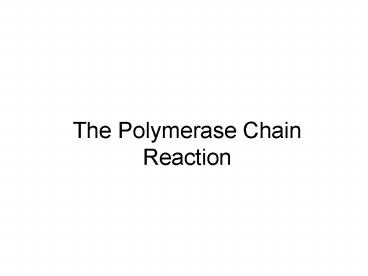The Polymerase Chain Reaction - PowerPoint PPT Presentation
1 / 17
Title:
The Polymerase Chain Reaction
Description:
... denaturation (step 1) to allow primers to bind or 'anneal' to the ssDNA template. Mg affects the annealing of the primer to the template DNA by stabilizing the ... – PowerPoint PPT presentation
Number of Views:46
Avg rating:3.0/5.0
Title: The Polymerase Chain Reaction
1
The Polymerase Chain Reaction
2
Polymerase Chain Reaction
- Developed by Kary Mullis in mid-1980s
- Revolutionary methods of gene analysis
- Enablement of production of enormous numbers of
copies of a specified DNA sequence without the
reliance to cloning
3
PCR amplifies specific regions of DNA
- Exploitation of certain features of DNA
replication - Specifically, DNA polymerase which uses ssDNA as
template for synthesis of a complementary new
strand
4
DNA review
- dsDNA strand is held together by weak hydrogen
bonds between 2 of 4 nitrogenous bases that are
complimentary to one another - Adenine-Thymine
- Cytosine-Guanine
- Strands are anti-parallel, 5 ? 3 counter to 3
? 5
5
PCR amplifies specific regions of DNA
- Utilization of a cyclical run of temperature
fluctuations thereby allowing the newly created
dsDNA to serve as a template for further daughter
DNA strands - ssDNA templates are produced by heating the dsDNA
to be point of boiling (step 1) - Requirement of DNA polymerase of a small section
of dsDNA to initiate or prime the synthesis
(step 2)
6
Primers
- Selection of primers based on sequences
juxtaposed on both sides of the target of
interest - Two primers should be designed one for each
strand - 18-24 bp
- Both primers should have similar Tm
- PurinePyrimidine content as close as 11
(40-60) - Avoiding primer-primer interactions
- Cooling of reaction after denaturation (step 1)
to allow primers to bind or anneal to the ssDNA
template - Mg affects the annealing of the primer to the
template DNA by stabilizing the primer-template
interaction, it also stabilizes the replication
complex of polymerase with template-primer
7
Primers
- 5CTATGGATAAGATGAGAGGACTAAATGTATGAGAGAGTAATAGA
GAG3 - 3GATACCTATTCTACTCTCCTGAT.TTACATACTCTCTCATTATC
TCTC5 - step 1 (denature)
- 5CTATGGATAAGATGAGAGGACTAAATGTATGAGAGAGTAATAGA
GAG3 - 3GATACCTATTCTACTCTCCTGAT.TTACATACTCTCTCATTATC
TCTC5 - step 2 (anneal)
- 5CTATGGATAAGATGAGAGGACTAAATGTATGAGAGAGTAATAGA
GAG3 - 3ACTCTCTCATTATCTC5
- 3GATACCTATTCTACTCTCCTGAT.TTACATACTCTCTCATTATC
TCTC5 - 5GGATAAGATGAGAGG3
- step 3 (extend)
- 5CTATGGATAAGATGAGAGGACTAAATGTATGAGAGAGTAATAGA
GAG3 - 3TACATACTCTCTCATTATCTC5
- 3GATACCTATTCTACTCTCCTGAT.TTACATACTCTCTCATTATC
TCTC5
8
Extension
- Use of taq DNA polymerase to synthesize new
strand of DNA, complementary to template, that
extends to a variable distance from the primer
binding site, using the available separate
deoxynucleotides in the reaction - dATP, dCTP, dTTP, dGTP
- taq DNA polymerase has a higher error rate (no
proof-reading 3' to 5' exonuclease activity)
9
Cyclic reaction
- Post-extension involves the repeat of the entire
process which causes the newly formed dsDNA to
denature - The newly synthesized dsDNA are separated into
ssDNA, and 4 binding sites are available for
primers to anneal - Taq polymerase synthesizes the new complementary
strand, however, the extension of these new
strands is limited to the target sequence
10
Amplification of target sequence only
- extension (step 3)
- denature (step 1)
11
Amplification of target sequence only
- annealing (step 2)
- extension (step 3)
12
Exponential Amplification
13
(No Transcript)
14
Resolving PCR products
- Polyacrylamide gel electrophoresis
- Higher resolving power separation of DNA
molecules whos lengths differ by as little as .2 - Accommodation of higher quantities of DNA (up to
10 ug) without resolution loss - Higher purity of DNA can be extracted
- Nondenaturing PAGE gels for separation and
purification of dsDNA fragments - However, electrophoretic mobility is affected by
base composition (in addition to size) - Denaturing PAGE gels for separation and
purification of ssDNA fragments - Usually urea, formamide is used to suppress base
pairing in nucleic acids - Denatured DNA migrates at a rate independent of
base composition
15
Resolving PCR products
- Agarose gel
- Lower resolving power, but greater range of
separation (200 bp to 50 kb) - Buffers
- TAE (tris acetate) has low buffering capacity
(ionic strength) - TBE (tris borate) and TPE (tris phosphate) have
higher buffering capacity
16
Resolving PCR products
- Visualization of DNA via fluorescence
- Ethidium bromide
- Insertion between the bases of the DNA
- EtBRDNA complex displays an increase fluorescent
yield compared to dye in free solution - Yield is lower for ssDNA
17
Metaphor Agarose
- Intermediate melting temperature
- 2x resolution capabilities of agarose
- Resolution of products differing in size by 2,
in the range of 200 bp to 800 bp































